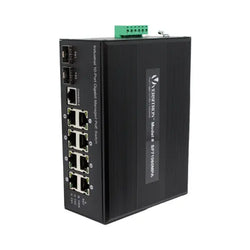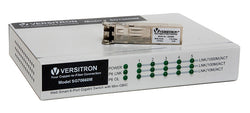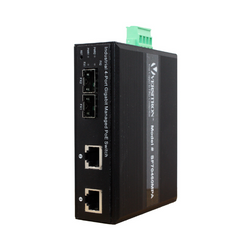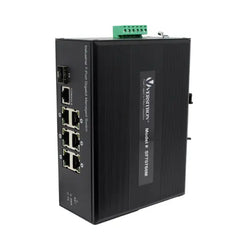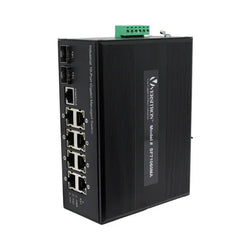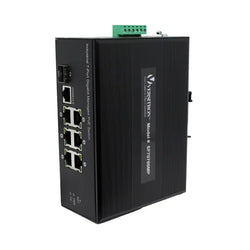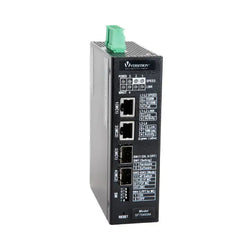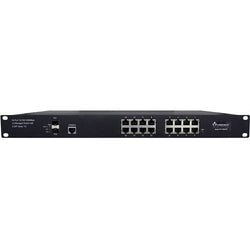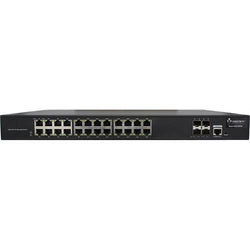Managed Switches
A managed network switch allows Ethernet devices to communicate and interact with one another within the same network. Managed switches provide the tools necessary for configuring and monitoring traffic on a Local Area Network (LAN). They also allow for seamless communication between Ethernet and Fiber Optic devices no matter where the equipment is located.
VERSITRON provides a broad selection of industrial and commercial managed internet switches with gigabit and fast Ethernet combo ports in varying port size configurations. Our managed Ethernet switches come with SFP slots, PoE and PoE+ ports, and are equipped with network protocols such as PROFINET, SNMP, and IP/Ethernet, which help establish consistent communication and data packet exchange between devices in the network.
Managed Industrial Switches Managed Industrial PoE/PoE+ Switches Managed Commercial Switches Managed PoE Switches
Features Provided By VERSITRON Managed Switches
Our managed network switches have been successfully installed in various applications throughout the military and commercial sectors. Device attributes include the following:
- Our Managed Ethernet to Fiber Switches provide a reliable infrastructure for your business network.
- These switches deliver the intelligent features you need to improve the availability of your critical business applications, protect sensitive information, and optimize your network bandwidth to deliver information and applications more effectively.
- Managed ethernet switch provide many capabilities and functionality requirements for entry-level networking for all business and enterprise applications and also help you to create a more efficient, better-connected workforce.
- VERSITRON manufactures managed gigabit switches that provide the following features including QoS, Rapid Spanning Tree Protocol (RSTP), VLAN (Virtual Local Area Networking), Link Aggregate Control Protocol (LACP), Port Mirroring for Network Monitoring, Bandwidth Control Function, Device Management System (DMS), DHCP Snooping and Relay.
- Port sizes range from 2 to 48 so that you can choose the correct device for your application requirements.
- Our industrial-managed switches are known for their quality and performance and are compliant with ECC Class A, CE mark/EMC Class A, EN60950/IEC60950-1, and NEMA TS2-2033.
- Our fully managed lan switches can be used for port-based VLAN and 802.1Q tag-based VLAN.
Applications of VERSITRON’s Managed Network Switches
Our fully managed switches are used in the following applications:- IP/PoE surveillance networks
- Factory automation networks
- Business data transmission networks
- High-capacity data centers
Frequently Asked Questions on Managed Network Switches
Our experts work closely with clients and regularly answer their questions on managed network switches. The following are a few common questions answered by our team:- When should you use a managed switch?
A fully managed switch is required to manage your home, commercial, or industrial network in the following scenarios:- Smart managed switches can be used to integrate IoT devices in industrial and residential networks.
- Managed internet switches allow users to control the device operations efficiently. For instance, you can use these switches to set commands for equipment on/off.
- These switches feature a link aggregation control protocol (LACP) that allows effective data load distribution in the network.
- The VLAN feature of these switches helps distribute the network traffic and avoid clogging even if all the devices are used simultaneously.
- How do you control a managed switch?
A managed switch comes with multiple features and can be used to manage or control various functions.- RSTP:This is a redundancy protocol that allows users to prevent network loops by blocking the redundant paths. The loops can affect the performance of networks in many ways, such as by producing erratic MAC address tables, duplicate data, and broadcast storms.
- Port Trunking:This feature helps improve network throughput. In this, several physical channels are combined into a single channel and the performance of this channel equals to the sum of links.
- Port Security:Performed by assigning MAC addresses to individual ports. This restricts the port access to a particular device.
- What is a VLAN on a managed lan switch?
VLANs or virtual LANs help divide a network into different small subnets. These subnets allow certain devices to work together, regardless of whether they exist on the same physical LAN or not. Nowadays, most businesses use LANs to partition their core network and manage their traffic accordingly.
- What is the difference between a Router and a Managed Switch?
A managed switch can be used to connect multiple devices, including computers, wireless access points, servers and printers on the network. These switches enable these devices to share information with each other. A router can be used to connect multiple switches and their networks. This allows the formation of a large network. In addition to connecting various networks, the routers also enable multiple users and devices in a network to access the internet. Both a managed network switch and a router ensure your business connectivity and protect vital business information from security threats.
- What does 10/100/100 Ethernet port on the switches mean?
The 10/100/1000 Ethernet port features gigabit speeds up to 1000 Mbps; however, it can also support slow data speeds of 10 Mbps or 100 Mbps.
- What is a combo port on the Ethernet switch?
Some of our switches feature combo ports. These ports consist of two Ethernet interfaces – SFP Fiber and RJ45 Ethernet ports. In the case where combo ports exist, both an Ethernet port and a fiber port cannot be used simultaneously. Typically, when the SFP port is activated, the RJ45 port is automatically disabled.
- Does a managed switch need an IP address?
Yes, managed switches need an IP address. The IP address helps users configure and monitor the switch remotely.
- Does your switch support PoE?
Yes, we manufacture many switches with PoE and PoE+ capability.
- Are these managed network switches stackable?
Yes, certain models are stackable and support stacking up to 4 models

